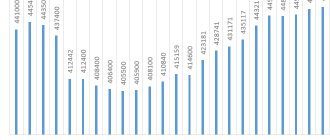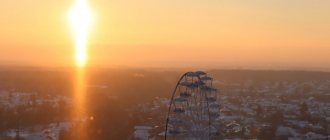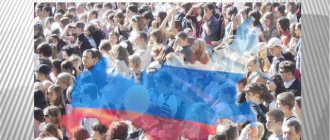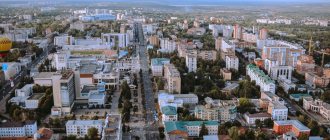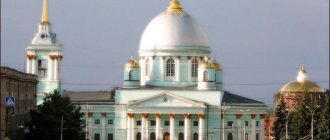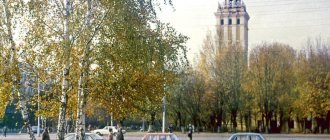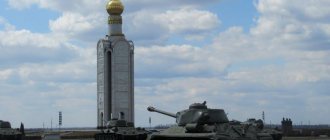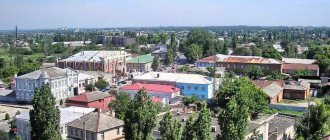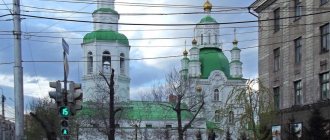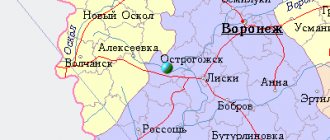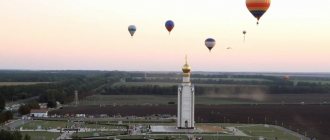Archive number No. 39 (989) dated September 24, 2013 - Planet of Mysteries
HISTORY AND PRESENT
On September 25, Kursk celebrates its next birthday; the city turns 981 years old. Today it is changing literally before our eyes: whole new microdistricts are appearing. And those grains of history that remain in the appearance of the ancient city flow away like sand through your fingers. How much has been preserved from old Kursk? We compared photographs from the beginning of the 20th century and modern ones.
The main square of Kursk, defined by the first urban plan in 1782, was called Krasnaya (as all the best was then called), although by that time it was only a vast space that had burned out after a devastating fire. During its existence, it changed its size and configuration, was divided and supplemented by other squares with different names (Bazarnaya, Navoznaya - from the concept of manure, bringing supplies). The southern part of the square was called Znamenskaya. By the way, this year the Znamensky Monastery turns 400 years old.
* * *
The main highway of Kursk, which was formerly called Moskovskaya Street, begins from Red Square. In 1918, on the first anniversary of the revolution, it was renamed Lenin Street. In 1934, Kursk became a regional center and special attention began to be paid to the appearance of its main street. For the first time, Lenin Street was paved, the crooked wooden poles carrying the tram wire were removed, and a storm drain was installed. During the Great Patriotic War, the street was almost completely destroyed, and after its end it was restored.
* * *
In 1900, on the site where the police department building is now located, the 2nd women's gymnasium was opened. People called it “green” - after the color of the students’ uniforms. The Mariinsky Gymnasium was “red”. The building of the 2nd gymnasium, which later housed one of the Kursk schools, was destroyed during the war.
* * *
On Frolovskaya Street, which we call Radishchev Street, was located the Mariinskaya Gymnasium, the oldest female secondary educational institution in the Kursk province. During the war, the building was badly damaged, but immediately after the liberation of Kursk, work began on restoring the destroyed educational building. Today, students of Kursk State University study in these classrooms.
* * *
The two-story stone mansion on Moskovskaya Street once housed a public club. If in the prim Assembly of the Nobles only 5-6 evenings with dancing and music were given throughout the year, then with the opening of a public club life in the city became noticeably livelier. Family evenings here gave way to cheerful masquerades, Sunday dinners with high piles of pancakes ended with dashing troika rides. Later, a teachers' seminary was opened in the mansion. Surprisingly, over the course of a century and a half, the building has not undergone any fundamental changes, except that the once tall wooden tower of the meteorological observatory operating at the seminary finally disappeared. Now the administration of the Kursk diocese is located here.
* * *
“So, here is another one of those places that - if it weren’t in Russia - would have long ago served as a subject of pilgrimage for tourists. Firstly, it is located magnificently and vaguely resembles the outskirts of Florence, no matter how funny such a statement may seem,” Fyodor Tyutchev shared his impressions of Kursk. I was delighted by the view of Streletskaya Sloboda and Empress Catherine II. The Tuskar River, channels and creeks, sparkling under the rays of the bright summer sun, made her compare the surroundings of the city with Venice.
* * *
In 1787, in honor of the passage of Catherine II through Kursk, the triumphal Kherson Gate was built at the end of Khersonskaya Street (present-day Dzerzhinsky Street). The tradition of that time was to install spiers outside the main city gates. In essence, these were outposts where, if necessary, the identities of those entering and their cargo were checked. When the outpost ceased to fulfill its direct functions, the columns stood for a long time until they were demolished in the 20th century, as they interfered with the movement of public transport.
Modern photos - Andrey KORNILOV
Share link:
Subscribe to “For Each Other”:
Yandex News Yandex Zen Google News YouTube Video
KURSK
KURSK, city in Russia, adm. center of Kursk region and municipal district, forms an urban district. Population 451.0 thousand people. (as of 1.1.2021). Located in the center. parts of the region, on the river Tuskar, at its confluence with the river. Sejm. Railway node The federal highway “Crimea” passes through K. (Moscow – Tula – Kursk – Orel – Belgorod – border with Ukraine). Kursk Airport (Vostochny; jointly based civil and military aviation; passenger traffic 38.2 thousand passengers in 2019).
Story
Kursk Znamensky Cathedral. 1816–26. Photo by A. I. Nagaev
Kursk Cathedral in honor of the Kazan Icon of the Mother of God and Sergius of Radonezh. 1752–78.
It probably arose in the 9th century. as a fortified settlement of slavs. tribe of northerners. After the final entry of Posemya (the region in the Seim River basin) into the con. 10th century included in Old-Russian state of K. to the beginning 11th century turned into a city that became one of the strongholds of the Kyiv princes to the southeast. borders of the state. The first written evidence about K. is contained in the Life of St. Theodosius of Pechersk (early 1030s) and in the “Instructions” of the Kyiv prince. Vladimir Vsevolodovich Monomakh (events of autumn 1068). Population of K. in the 1st half. 11th century carried military service, submitting to the authority of the mayors of Kyiv and Chernigov (1024–36) princes. Since 1054 as part of the Pereyaslavl Principality. The favorable geographical position of the city and the possibility of establishing direct contacts with nomads attracted Russians here. princes. The road to Chernigov and Pereyaslavl passed through K. After the defeat from the Polovtsians on the river. Alta, in the fall of 1068, the Pereyaslavl prince took refuge in K. Vsevolod Yaroslavich. Under 1095 K. was first mentioned in the Tale of Bygone Years; there was a temporarily created princely table in it, which was occupied by the son of Vladimir Monomakh, Izyaslav Vladimirovich. From the 1st third of the 12th century. - the center of the Kursk principality. Cultural layer 11th–13th centuries. fixed to the center. parts of modern K. The fortified Detynets (approx. 10 hectares) was located on a cape at the confluence of the Kur and Tuskar rivers (defensive structures, wooden pavement flooring were studied; among the finds were fragments of a plinth, an encolpion cross, arrowheads, decorations, bone buttons and an overlay from comb, etc.). Verkhny Posad is localized in the area of modern. Red Square and Park named after May 1 (a part of the estate consisting of two log buildings was studied; among the finds were crosses, an iron writing, a clay Easter egg, jewelry, arrowheads, a spindle whorl, etc.). The lower settlement was identified to the southwest of Detinets, on the right bank terrace of the river. Chicken In 1239 it was devastated during the Mongol-Tatar invasion, but was soon restored. Ruined again by the Horde at the end. 13th century, after which it fell into disrepair for a long time. In the 14th–16th centuries. K. is mentioned several times in various. Russian, Lithuanian and Crimean Tat. sources, however, direct evidence of its existence as a mountain. there was no settlement during this period.
Photo by P. S. Pavlinov Kursk. View of Lenin Street from Red Square. On the left is the Central Hotel (1948–56), on the right is the city administration building (1948–60).
The revival of K. is associated with the construction in 1596 under the direction of. Voivode I. O. Polev of the wooden Kursk fortress (dismantled in the 1780s). From the end 16th century K. became the center of the county. In 1604, as a result of a rebellion, it came under the control of False Dmitry I. The people of Kursk took part in the Bolotnikov uprising of 1606–07. In 1606, K., along with other northern cities, refused to recognize the power of Tsar Vasily Ivanovich Shuisky and supported False Dmitry II. In 1612, 1616 and 1617, during the intervention of the Polish-Lithuanian Commonwealth at the beginning of the 17th century, as well as in 1634, during the Russian-Polish. war of 1632–34, withstood the sieges of the Polish-Lithuanians. troops. In the 1st half. 17th century K. and his district were repeatedly subjected to raids by the Crimean khans and attacks by the Nogais. After the construction of the Belgorod line, K. became one of the largest trade and craft centers in the south of Russia. state District city of the Kyiv province (1708–27; in 1712–19 the center of the Kursk province), Belgorod province (1727–79). Center of the Kursk province (1779–1928; in 1779–96 – Kursk governorship). In the 18th century was the most important center of transit trade between the center. and south lands of Russia and Little Russia. There was a border customs office in the city. K ser. 18th century K. became one of the ten largest cities in Russia. empires. The railway lines passed through K.: Moscow - Kursk (1868), Kursk - Kharkov (1869), Kursk - Kyiv (1870), Kursk - Voronezh (1894).
11/26/12/9/1917 Soviet Union was installed in K. power. During the Civil War of 1917–22, it was occupied by units of the Armed Forces of the South of Russia (September 20, 1919), and on the night of November 17–18. 1919 – by units of the Workers' and Peasants' Red Army during the Counter-Offensive of the Southern Front. District and district city of the Central Chernozem Region (1928–30), since 1930 a city of regional subordination of the Central Chernozem Region. (1930–34), Kursk region (since 1934). Adm. center of Kursk region (since 1934). During the Great Patriotic War, Germany was occupied on November 4, 1941. troops. Liberated on February 8, 1943 as a result of the Kharkov operation. During the Battle of Kursk, from July 5 to August 23, 1943, being a key strategic. point on the Kursk Bulge, was subjected to massive German attacks. aviation. In 1945, by decree of the Council of Ministers of the USSR, it was included among the 15 historical. cities that are subject to priority restoration. The post-war period in the history of Kazakhstan was marked by intensive industrial development, rapid population growth, and therefore. expansion of the mountains territories. Since 2004 it forms a city district. In 2007, K. was awarded the title “City of Military Glory.”
Architecture
On the territory of the former Kursk fortress, on the right bank of the river. Tuskar, located: Znamensky men's monastery ensemble. [founded in 1613 as a mon. Nativity of the Blessed Virgin Mary, modern. name from ser. 17th century, closed in 1924, revived in 1992; Znamensky Cathedral in the style of classicism, 1816–26, presumably by architect. A.I. Melnikov, construction manager - architect. P. K. Shmit; rebuilt into a cinema in the 1930s, architect. L. A. Litoshenko, restored in the 1990s; Voskresenskaya c. – 1875; tower and part of the wall - con. 18th century], Bishop's House (late 18th - early 19th centuries, extensions - 1853; now a local history museum), buildings of the men's gymnasium (1836–44, architects P.S. Groznov, A.P. Bryullov, rebuilt in 1950), the Assembly of the Nobility (1877; now the House of Officers and the Military Historical Museum of the Battle of Kursk).
Below on the right bank of the river. Tuskar preserved Holy Trinity (Lower) Church. (1740–42, 1782, extensions - 1829 and 1840), so-called. chambers of the Romodanovsky boyars (house of Khloponin, 2nd half of the 18th century; now the Museum of Archeology). Above ex. fortresses along the river Tuskar is located Holy Trinity Women's Monastery. (founded presumably in the late 16th century, mentioned in 1623, closed in 1923, revived in 1994) with the Holy Trinity (Upper) Church. (1695–1703, in 1836 a church was added in honor of the Novodvorsk Icon of the Mother of God), a rectory (1880) and a parochial school (1910–11). The city has preserved: churches ser. 18th–19th centuries – Vvedenskaya (Bishops’ Compound; 1761–1762, 19th century), Archangel Michael (“sea”; 1767, late 1830s – early 1840s), Voskresensk-Ilyinskaya (1768); Cathedral in honor of the Kazan Icon of the Mother of God and Sergius of Radonezh, in the Baroque style (1752–78); St. Nicholas (1800–14), Ap. John the Theologian (1809), Dormition Edinoverie (1812–1814; now Old Believers); All Saints, in the style of classicism (St. Catherine, 1813–36).
Since 1782, K. was built according to a regular plan with a rectangular grid of streets, the basis of which was converging at an angle on Red Square. Moskovskaya (now Lenin) and Khersonskaya (now Dzerzhinsky) streets. Among the civil buildings in the style of classicism: decorated with three Ionic. porticoes of the building of the Order of Societies. charity (formerly Denisyev's house, now the building of a regional hospital, 1783–1790, presumably by architect G. Quarenghi), former. treasurer's house (late 18th century), manege (1820, architect K. I. Hoffman; rebuilt as a theater in 1886, architect A. I. Gross; received its current appearance in 1901, reconstructed in the 1980s. ). All R. 19 – beginning 20th centuries built: Uspenskaya Ts. (Martyr Nikita, 1846), Voznesenskaya Ts. (1886–87), c. St. Seraphim of Sarov (1905); Assumption Church in the neo-Gothic style (1892–1896), Lutheran Church of Saints Peter and Paul (1895, closed and rebuilt in the 1920s; now the building houses the regional prosecutor’s office), Treasury Chamber (1880–1903, architect K. A Borisoglebsky; now the Assembly College), Gladkov's house (1890; now a medical college), the former building. Department of the Moscow-Kiev-Voronezh railway. (1897–1902), a mill complex (early 20th century), the State Bank building in the Art Nouveau style (1912, architect F. O. Livchak), the summer theater in the Merchant Garden (1912, the first monolithic building in Kazakhstan reinforced concrete; now Park named after May 1), the so-called. People's House (1910–25; both – architect B. G. Peretyatkovich).
In the 1920s–50s. built: residential buildings in the constructivist style on the street. Dzerzhinsky, Med. institute (1933–34, architect L.M. Bulkovshtein; now univ.), adm. Internal Administration building business on the street Lenin (1948, architects V.S. Popov, A.N. Ivanov), Book House (1951–55, architect M.L. Teplitsky), railway. club (1950, architect N.A. Vishnyakov), stadium "Labor Reserves" (1950, architect A.G. Shuklin), station (1949–52, architects I.G. Yavein, N.F. Shimbarevich), complex of agricultural buildings Institute (1952–54, architects I. N. Gulin, V. G. Kremlev and others; now the Agricultural Academy named after Prof. I. I. Ivanov). According to the general plan for the restoration and development of K., Ch. arr. along the street Lenin and st. Dzerzhinsky. Ensemble of Red Square completed by the House of Soviets (1939–47, architect Shuklin; now the building of the administration of the Kursk region), the building of the city committee of the CPSU and the city council (1948–60, architects P. G. Stenyushin, N. S. Vlasenko; now the building of the city administration), hotel “Central” (1948–56, architects P. G. Stenyushin, N. S. Vlasenko, A. N. Ivanov) and the House of Communications (1950–51, architects D. I. Garkusha, Ivanov). Among the buildings of the 1960s–80s: circus, administrative building. Center building district, new Dramatich building. Theater named after A. S. Pushkin (1983, architects E. G. Rozanov, L. A. Lavrov), 16-story hotel with a restaurant (architect Lavrov).
Monuments to: V. I. Lenin (1956, sculptor M. G. Manizer; architects I. E. Rozhin, A. P. Velikanov), A. A. Deineke (1999, sculptors N. P. Krivolapov, I. A. Minin), A. S. Pushkin (1999), St. Alexander Nevsky (2000), K.K. Rokossovsky (2005, sculptor V.M. Klykov), local natives E.I. Nosov (2005, sculptor V.I. Bartenev) and G.V. Sviridov (2005, Krivolapov, Minin), V. M. Klykov (2007, sculptor A. V. Klykov), the crew of the Kursk submarine (Krivolapov, Minin, 2003), etc. Stele “To the Heroes of Kursk” (1966). Memorial complexes: “Heroes of the Civil War” (1977), “In memory of those who fell in the Great Patriotic War” at the Military Cemetery (1983, architect M. L. Teplitsky), “Kursk Bulge” [1998; includes the Arc de Triomphe (2000), c. St. George the Victorious (1998–2008), monument to G.K. Zhukov (1998, sculptors Bartenev, Minin)].
Centers of science and culture
K. is a major center of education, science and culture of the Russian Federation. Among the scientific institutions are the Kursk Federal Agrarian Research Center (formed in 2022 by the merger of the Kursk Research Institute of Agro-Industrial Production, the All-Russian Research Institute of Agriculture and Soil Protection from Erosion, the Russian Research Institute of the Sugar Industry), the Center for Scientific and Technical Information (founded in 1958, since 2010 a branch of the Russian Energy Institute Agency), Institute of Environmental Safety (1992). Universities: Kursk State. University (its history dates back to the Mariinsky School, founded in 1860, the name and status have changed several times, since 1934 Pedagogical Institute, modern name and status since 2003), Kursk State University. honey. University (1935, current name and status since 1994), Kursk State Agricultural University Academy named after prof. I. I. Ivanova (1951, current name and status since 1994), South-Western State. University (founded in 1964 as the Polytechnic Institute, current name 2010), etc. Theological Seminary (1787, current status since 1992). Regional libraries: Scientific library named after. N. N. Aseeva (1935), Scientific medical. b-ka (1945), etc., 2 municipal centralizations. library systems.
Museums: state regional local history museum (established in 1903 as a historical, archaeological and handicraft museum in memory of Emperor Nicholas II’s visit to Kaiser in 1902, opened in 1905, current name since 1934), includes 17 branches, including 2 in Kursk: military history. museum “Young Defenders of the Motherland” (1963, since 1977 a public museum, current status since 1991) and a planetarium (1995). Kursk Regional Art Gallery named after. A. A. Deineki. Military-historical Museum of the Battle of Kursk (opened in 1963), Regional Museum of Archeology (established in 1990 as the archeology department of the Kursk State Regional Museum of Local Lore, since 1993 an independent museum), Memorial House-Museum of the natives of Kazakhstan - astronomer F. A. Semenov and his grandson, inventor A. G. Ufimtsev (1986).
Dramatic Theater named after A. S. Pushkin (1792), Puppet Theater (1944), Youth Theater "Coeval" (1966). Regional Philharmonic (1936), composed of: Symphony. orchestra (1992), ensemble “Russian Mosaic” (1994). Choir Chapel “Kursk” (1987, on the basis of the Music Society of the Kursk region). Variety-symphonic orchestra (2001). Russian Chamber Orchestra of Kursk State. University (2002). At the Regional House of People. creativity - Kursk people. choir named after S. G. Chagovets (1958), folk ensemble “Casket” (1994), choir “Front-line Girlfriends” (1985), jazz vocal ensemble “Sixth Sense”, vocal ensemble “Kurskie Dawns”. All-Russian annual festivals: the author's song "Nightingale Trill" (since 1989, founded as an all-Union festival), "Russian Romance" (since 1993), named after. G. V. Sviridov (since 2001; within its framework - the All-Russian open vocal music competition named after G. V. Sviridov), the Kursk Nightingale arts festival (since 2000).
Sport
The Avangard football team (founded in 1958), finalist of the Russian Cup 2022, plays at the Trudovye Reservy stadium (built in 1948; over 11 thousand seats). Women's basketball club "Dynamo" (1994; until 1997 called "Svetlana") - winner of the Euroleague 2022 and winner of the European Cup 2012. In 1965, K. hosted matches of the Bandy World Championship.
Farm
K. is the largest industrial center of Kursk region The most developed are mechanical engineering, chemical, light and food industries.
Leading mechanical engineers. enterprises: "Mayak" - a branch of the Nizhny Novgorod Scientific and Production Association named after M. V. Frunze (1956; as part of the Radioelectronic Technologies concern; devices and systems for radiation and dosimetric monitoring, radio measuring instruments, vacuum gauges, medical equipment and consumer goods), "Aviaavtomatika" named after V.V. Tarasov (1959; until 2014 -; aviation on-board and ground equipment, electric drives for automated control of pipeline fittings of the fuel and energy complex, as well as consumer goods), "Electroagregat" (founded in 1953 as the Kursk plant mobile units; autonomous and backup power supplies, gasoline and diesel power plants, generators, welding units and equipment, frequency converters, as well as household pumps and other consumer goods), Kursk Battery Plant (1944; one of the largest enterprises of this profile in the Russian Federation, production of lead-acid batteries, alkaline, nickel-iron and nickel-cadmium batteries and batteries), Kursk Electrical Equipment Plant (founded in 1945 as , modern name and status since 2011; one of the largest manufacturers of electrical products in the Russian Federation; low-voltage equipment: automatic and modular switches, differential protection devices, various relays, programmable timers with photo relays and voltage control, electricity meters, frequency converters, voltage stabilizers, fuses, electrical installation products, etc.), "Schetmash" (1948; cash register equipment, voltage stabilizers, automotive electrical and computer equipment). There are also: "Elevatormelmash" (1946; a division of the "Grain Systems" corporation; equipment for mills, elevators and feed production: unloading and loading, transporting, aspiration, grain cleaning, etc.), Kursk Bearing Plant (APZ-20; 1972; from 2002 as part of the Kursk Bearing Company; bearings of 500 standard sizes, spare parts and components for the modernization of railway rolling stock, metal blanks) and Sovtest ATE (founded in 1991 as a joint Russian-British venture, since 1994 independent; functional control test equipment, etc. .).
Basic manufacturer of chemical products industry of K. and Kursk region. – enterprise "Kurskrezinotekhnika" (1946; since 2013 in the structure of the Rubex Group holding; conveyor and conveyor belts, high-pressure hoses and hoses, hoses with textile and metal reinforcement, drive belts, parts for mining equipment, railway rolling stock and agricultural machinery, dielectric and car carpets, etc.). Dr. large enterprises: a branch of the company "Biaksplen" (formed in 2005 as , since 2007 - as part of , since 2009 - the current name and status as part of the petrochemical holding "Sibur"; the first plant in Russia for the production of biaxially oriented polypropylene film; a total of 40 types of film for packaging of food products and tobacco products, labels, etc.), scientific and production association "Composite" (1992; flexible rubber pipelines for hydromechanized work and wear-resistant pipelines for mining enterprises; export to Uzbekistan, Kazakhstan, Ukraine, Poland, Turkey, North Macedonia, India, Iran, Egypt, Chile and Peru), (1960; as part of the group; technical and textile threads, staple fiber, cord fabric for reinforcing tire tires - in total over 100 types of polyamide threads and fibers; export to the CIS countries , Italy, Spain, the Netherlands, Czech Republic, Poland, Greece, USA, Turkey, Iran, Vietnam, Indonesia, etc. about 40% of production). In Kazakhstan there are Pharmstandard-Leksredstva (as part of the Pharmstandard company; one of the leading Russian enterprises for the production of medicinal products), Kursk Biofactory (a large Russian manufacturer of immunobiological veterinary drugs), Kursk Medical Plant. glass (production of glass packaging, including ampoules for medicines). Operating enterprises (2005): “ProjectPartner” (production of cardboard printing and paper packaging, sheet printed products), “GofroPak” (corrugated cardboard and packaging made from it, as well as molded plastic packaging), “LabelPak” (flexible packaging, label products, and also flexible instrument panels and keyboards made using screen printing technology), and the Kursk Large-Panel House Construction Plant named after A.F. Deriglazov.
The leading enterprises of light industry are the industrial association concern "Kursktrikotazhprom" (founded in 1968 as the Kursk Knitting Factory, current name and status since 2002; production of synthetic yarn with the addition of wool, cotton, flax, viscose and metallized thread, knitted fabric, men's, women's, children's and underwear knitwear, school uniforms), Kursk technical factory. fabrics (technical harsh and awning fabrics, rubber-fabric belts, conveyor belts, rubber and rubber-fabric plates, flexible ventilation shaft pipes, scrapers for snow removal machines); "KurskObuv" (as part of the Komplekt holding; production of children's and teenage shoes), a factory (bed linen and home textiles) and a children's clothing factory "Trading House "Slavita" (1995; children's clothing and school uniforms made of wool blend and cotton fabric, Polartek, footer, felted wool and velor, knitted wool blend fabrics), "Technotex" (1992; twine and ropes made of natural fibers: hemp, flax, jute, sisal).
Among the large food industry enterprises is the “Fresh Bread Project” [2015; company headquarters and bakery (founded in 1976 as “Bread” (since 2006 as part of the agro-industrial corporation “Stoilenskaya Niva”; produces about 60% of flour in the Kursk region, also produces high-quality feed for all types of farm animals and poultry), "Kurskhleb", "Kurskmakaronprom" (production of pasta, vermicelli, noodles, horns, etc.), Kursk meat processing plant "LIKO" (2010; pork processing, frozen meat, boiled and boiled-smoked sausages, sausages and meat delicacies) , “Kursk Milk” (2005; drinking milk, fermented milk products, butter, cottage cheese, processed cheese), Kursk Cold Storage Plant (1959; ice cream, frozen semi-finished products: dumplings, filled pancakes, vegetable cutlets, etc.), factory “Konti- Rus" (founded in 1935 as the Kursk Confectionery Factory, modern name since 2004; chocolate, chocolate, jelly and caramel candies, cookies, biscuits, marshmallows, soufflés and waffles), branch "Grainrus - Kursk Malt" (created on the basis of ; volume production of 125 thousand tons of malt per year), “Brewery No. 1” (2003; production of beer, beer drinks, kvass, soft drinks).
The electric power industry is represented by the following enterprises: Kursk CHPP-1 (1955; installed capacity 125 MW; main fuel is natural gas, reserve fuel is coal and fuel oil), Kursk CHPP NWR (CHP of the North-Western region; 2011; 116.9 MW; main fuel natural gas, reserve - fuel oil), Kursk CHPP-4 (1934; reconstruction in 2010–13; 4.8 MW; natural gas), all three are under control.
Neighborhood
Near K. - Kursk Root Hermitage; In the surrounding area there are preserved former estate: Nelidovykh in the village. Mokva 1st (neo-Gothic palace of the 1st half of the 19th century, stables of the mid-19th century, in the 1920s rebuilt into a club, English park), merchant G. A. Novosiltsev in the village. Lebyazhye (main house in the neoclassical style, late 19th – early 20th centuries; Holy Trinity Church, 1856). In the village Vinnikovo - Memorial Museum of local native N.V. Plevitskaya (1972) and a monument to her (1998, sculptor V.M. Klykov).
Up ▲ — Reader reviews (4) — Write a review ▼ — Print version
| city: Kursk | |
Thank you!
| Konstantin | 29 September 2013, 20:02:04 |
| city: Kursk | |
At the beginning of the twentieth century, Kursk looked, judging by photographs, much better than it does now. Architects thought much better than their contemporaries and truly built to last.
| Sergey | 1 October 2013, 11:54:23 |
| city: Kursk | |
I completely agree with you, Konstantin. It is a pity that the modern authorities are hampered by the historical sites of the city and Kursk is very quickly becoming miserable and black and white.
| Marina | 3 October 2013, 12:35:28 |
| e-mail, city: Kursk | |
Soon old Kursk will remain only in photographs. Many beautiful buildings in the center have been demolished, and dilapidated residential buildings are terrifying. Kursk a hundred years ago looked more interesting and colorful than it does now, when it became gray and merged with the other cities of the periphery.
